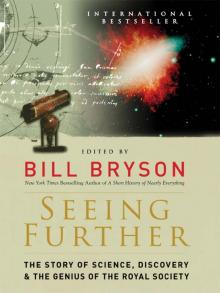- Home
- Bill Bryson
A Short History of Nearly Everything Page 3
A Short History of Nearly Everything Read online
Page 3
This was actually something of a blow to Pluto's status as a planet, which had never been terribly robust anyway. Since previously the space occupied by the moon and the space occupied by Pluto were thought to be one and the same, it meant that Pluto was much smaller than anyone had supposed--smaller even than Mercury. Indeed, seven moons in the solar system, including our own, are larger.
Now a natural question is why it took so long for anyone to find a moon in our own solar system. The answer is that it is partly a matter of where astronomers point their instruments and partly a matter of what their instruments are designed to detect, and partly it's just Pluto. Mostly it's where they point their instruments. In the words of the astronomer Clark Chapman: "Most people think that astronomers get out at night in observatories and scan the skies. That's not true. Almost all the telescopes we have in the world are designed to peer at very tiny little pieces of the sky way off in the distance to see a quasar or hunt for black holes or look at a distant galaxy. The only real network of telescopes that scans the skies has been designed and built by the military."
We have been spoiled by artists' renderings into imagining a clarity of resolution that doesn't exist in actual astronomy. Pluto in Christy's photograph is faint and fuzzy--a piece of cosmic lint--and its moon is not the romantically backlit, crisply delineated companion orb you would get in a National Geographic painting, but rather just a tiny and extremely indistinct hint of additional fuzziness. Such was the fuzziness, in fact, that it took seven years for anyone to spot the moon again and thus independently confirm its existence.
One nice touch about Christy's discovery was that it happened in Flagstaff, for it was there in 1930 that Pluto had been found in the first place. That seminal event in astronomy was largely to the credit of the astronomer Percival Lowell. Lowell, who came from one of the oldest and wealthiest Boston families (the one in the famous ditty about Boston being the home of the bean and the cod, where Lowells spoke only to Cabots, while Cabots spoke only to God), endowed the famous observatory that bears his name, but is most indelibly remembered for his belief that Mars was covered with canals built by industrious Martians for purposes of conveying water from polar regions to the dry but productive lands nearer the equator.
Lowell's other abiding conviction was that there existed, somewhere out beyond Neptune, an undiscovered ninth planet, dubbed Planet X. Lowell based this belief on irregularities he detected in the orbits of Uranus and Neptune, and devoted the last years of his life to trying to find the gassy giant he was certain was out there. Unfortunately, he died suddenly in 1916, at least partly exhausted by his quest, and the search fell into abeyance while Lowell's heirs squabbled over his estate. However, in 1929, partly as a way of deflecting attention away from the Mars canal saga (which by now had become a serious embarrassment), the Lowell Observatory directors decided to resume the search and to that end hired a young man from Kansas named Clyde Tombaugh.
Tombaugh had no formal training as an astronomer, but he was diligent and he was astute, and after a year's patient searching he somehow spotted Pluto, a faint point of light in a glittery firmament. It was a miraculous find, and what made it all the more striking was that the observations on which Lowell had predicted the existence of a planet beyond Neptune proved to be comprehensively erroneous. Tombaugh could see at once that the new planet was nothing like the massive gasball Lowell had postulated, but any reservations he or anyone else had about the character of the new planet were soon swept aside in the delirium that attended almost any big news story in that easily excited age. This was the first American-discovered planet, and no one was going to be distracted by the thought that it was really just a distant icy dot. It was named Pluto at least partly because the first two letters made a monogram from Lowell's initials. Lowell was posthumously hailed everywhere as a genius of the first order, and Tombaugh was largely forgotten, except among planetary astronomers, who tend to revere him.
A few astronomers continue to think there may be a Planet X out there--a real whopper, perhaps as much as ten times the size of Jupiter, but so far out as to be invisible to us. (It would receive so little sunlight that it would have almost none to reflect.) The idea is that it wouldn't be a conventional planet like Jupiter or Saturn--it's much too far away for that; we're talking perhaps 4.5 trillion miles--but more like a sun that never quite made it. Most star systems in the cosmos are binary (double-starred), which makes our solitary sun a slight oddity.
As for Pluto itself, nobody is quite sure how big it is, or what it is made of, what kind of atmosphere it has, or even what it really is. A lot of astronomers believe it isn't a planet at all, but merely the largest object so far found in a zone of galactic debris known as the Kuiper belt. The Kuiper belt was actually theorized by an astronomer named F. C. Leonard in 1930, but the name honors Gerard Kuiper, a Dutch native working in America, who expanded the idea. The Kuiper belt is the source of what are known as short-period comets--those that come past pretty regularly--of which the most famous is Halley's comet. The more reclusive long-period comets (among them the recent visitors Hale-Bopp and Hyakutake) come from the much more distant Oort cloud, about which more presently.
It is certainly true that Pluto doesn't act much like the other planets. Not only is it runty and obscure, but it is so variable in its motions that no one can tell you exactly where Pluto will be a century hence. Whereas the other planets orbit on more or less the same plane, Pluto's orbital path is tipped (as it were) out of alignment at an angle of seventeen degrees, like the brim of a hat tilted rakishly on someone's head. Its orbit is so irregular that for substantial periods on each of its lonely circuits around the Sun it is closer to us than Neptune is. For most of the 1980s and 1990s, Neptune was in fact the solar system's most far-flung planet. Only on February 11, 1999, did Pluto return to the outside lane, there to remain for the next 228 years.
So if Pluto really is a planet, it is certainly an odd one. It is very tiny: just one-quarter of 1 percent as massive as Earth. If you set it down on top of the United States, it would cover not quite half the lower forty-eight states. This alone makes it extremely anomalous; it means that our planetary system consists of four rocky inner planets, four gassy outer giants, and a tiny, solitary iceball. Moreover, there is every reason to suppose that we may soon begin to find other even larger icy spheres in the same portion of space. Then we will have problems. After Christy spotted Pluto's moon, astronomers began to regard that section of the cosmos more attentively and as of early December 2002 had found over six hundred additional Trans-Neptunian Objects, or Plutinos as they are alternatively called. One, dubbed Varuna, is nearly as big as Pluto's moon. Astronomers now think there may be billions of these objects. The difficulty is that many of them are awfully dark. Typically they have an albedo, or reflectiveness, of just 4 percent, about the same as a lump of charcoal--and of course these lumps of charcoal are about four billion miles away.
And how far is that exactly? It's almost beyond imagining. Space, you see, is just enormous--just enormous. Let's imagine, for purposes of edification and entertainment, that we are about to go on a journey by rocketship. We won't go terribly far--just to the edge of our own solar system--but we need to get a fix on how big a place space is and what a small part of it we occupy.
Now the bad news, I'm afraid, is that we won't be home for supper. Even at the speed of light, it would take seven hours to get to Pluto. But of course we can't travel at anything like that speed. We'll have to go at the speed of a spaceship, and these are rather more lumbering. The best speeds yet achieved by any human object are those of the Voyager 1 and 2 spacecraft, which are now flying away from us at about thirty-five thousand miles an hour.
The reason the Voyager craft were launched when they were (in August and September 1977) was that Jupiter, Saturn, Uranus, and Neptune were aligned in a way that happens only once every 175 years. This enabled the two Voyagers to use a "gravity assist" technique in which the craft were successively flung
from one gassy giant to the next in a kind of cosmic version of "crack the whip." Even so, it took them nine years to reach Uranus and a dozen to cross the orbit of Pluto. The good news is that if we wait until January 2006 (which is when NASA's New Horizons spacecraft is tentatively scheduled to depart for Pluto) we can take advantage of favorable Jovian positioning, plus some advances in technology, and get there in only a decade or so--though getting home again will take rather longer, I'm afraid. At all events, it's going to be a long trip.
Now the first thing you are likely to realize is that space is extremely well named and rather dismayingly uneventful. Our solar system may be the liveliest thing for trillions of miles, but all the visible stuff in it--the Sun, the planets and their moons, the billion or so tumbling rocks of the asteroid belt, comets, and other miscellaneous drifting detritus--fills less than a trillionth of the available space. You also quickly realize that none of the maps you have ever seen of the solar system were remotely drawn to scale. Most schoolroom charts show the planets coming one after the other at neighborly intervals--the outer giants actually cast shadows over each other in many illustrations--but this is a necessary deceit to get them all on the same piece of paper. Neptune in reality isn't just a little bit beyond Jupiter, it's way beyond Jupiter--five times farther from Jupiter than Jupiter is from us, so far out that it receives only 3 percent as much sunlight as Jupiter.
Such are the distances, in fact, that it isn't possible, in any practical terms, to draw the solar system to scale. Even if you added lots of fold-out pages to your textbooks or used a really long sheet of poster paper, you wouldn't come close. On a diagram of the solar system to scale, with Earth reduced to about the diameter of a pea, Jupiter would be over a thousand feet away and Pluto would be a mile and a half distant (and about the size of a bacterium, so you wouldn't be able to see it anyway). On the same scale, Proxima Centauri, our nearest star, would be almost ten thousand miles away. Even if you shrank down everything so that Jupiter was as small as the period at the end of this sentence, and Pluto was no bigger than a molecule, Pluto would still be over thirty-five feet away.
So the solar system is really quite enormous. By the time we reach Pluto, we have come so far that the Sun--our dear, warm, skin-tanning, life-giving Sun--has shrunk to the size of a pinhead. It is little more than a bright star. In such a lonely void you can begin to understand how even the most significant objects--Pluto's moon, for example--have escaped attention. In this respect, Pluto has hardly been alone. Until the Voyager expeditions, Neptune was thought to have two moons; Voyager found six more. When I was a boy, the solar system was thought to contain thirty moons. The total now is "at least ninety," about a third of which have been found in just the last ten years.
The point to remember, of course, is that when considering the universe at large we don't actually know what is in our own solar system.
Now the other thing you will notice as we speed past Pluto is that we are speeding past Pluto. If you check your itinerary, you will see that this is a trip to the edge of our solar system, and I'm afraid we're not there yet. Pluto may be the last object marked on schoolroom charts, but the system doesn't end there. In fact, it isn't even close to ending there. We won't get to the solar system's edge until we have passed through the Oort cloud, a vast celestial realm of drifting comets, and we won't reach the Oort cloud for another--I'm so sorry about this--ten thousand years. Far from marking the outer edge of the solar system, as those schoolroom maps so cavalierly imply, Pluto is barely one-fifty-thousandth of the way.
Of course we have no prospect of such a journey. A trip of 240,000 miles to the Moon still represents a very big undertaking for us. A manned mission to Mars, called for by the first President Bush in a moment of passing giddiness, was quietly dropped when someone worked out that it would cost $450 billion and probably result in the deaths of all the crew (their DNA torn to tatters by high-energy solar particles from which they could not be shielded).
Based on what we know now and can reasonably imagine, there is absolutely no prospect that any human being will ever visit the edge of our own solar system--ever. It is just too far. As it is, even with the Hubble telescope, we can't see even into the Oort cloud, so we don't actually know that it is there. Its existence is probable but entirely hypothetical. * 2
About all that can be said with confidence about the Oort cloud is that it starts somewhere beyond Pluto and stretches some two light-years out into the cosmos. The basic unit of measure in the solar system is the Astronomical Unit, or AU, representing the distance from the Sun to the Earth. Pluto is about forty AUs from us, the heart of the Oort cloud about fifty thousand. In a word, it is remote.
But let's pretend again that we have made it to the Oort cloud. The first thing you might notice is how very peaceful it is out here. We're a long way from anywhere now--so far from our own Sun that it's not even the brightest star in the sky. It is a remarkable thought that that distant tiny twinkle has enough gravity to hold all these comets in orbit. It's not a very strong bond, so the comets drift in a stately manner, moving at only about 220 miles an hour. From time to time some of these lonely comets are nudged out of their normal orbit by some slight gravitational perturbation--a passing star perhaps. Sometimes they are ejected into the emptiness of space, never to be seen again, but sometimes they fall into a long orbit around the Sun. About three or four of these a year, known as long-period comets, pass through the inner solar system. Just occasionally these stray visitors smack into something solid, like Earth. That's why we've come out here now--because the comet we have come to see has just begun a long fall toward the center of the solar system. It is headed for, of all places, Manson, Iowa. It is going to take a long time to get there--three or four million years at least--so we'll leave it for now, and return to it much later in the story.
So that's your solar system. And what else is out there, beyond the solar system? Well, nothing and a great deal, depending on how you look at it.
In the short term, it's nothing. The most perfect vacuum ever created by humans is not as empty as the emptiness of interstellar space. And there is a great deal of this nothingness until you get to the next bit of something. Our nearest neighbor in the cosmos, Proxima Centauri, which is part of the three-star cluster known as Alpha Centauri, is 4.3 light-years away, a sissy skip in galactic terms, but that is still a hundred million times farther than a trip to the Moon. To reach it by spaceship would take at least twenty-five thousand years, and even if you made the trip you still wouldn't be anywhere except at a lonely clutch of stars in the middle of a vast nowhere. To reach the next landmark of consequence, Sirius, would involve another 4.6 light-years of travel. And so it would go if you tried to star-hop your way across the cosmos. Just reaching the center of our own galaxy would take far longer than we have existed as beings.
Space, let me repeat, is enormous. The average distance between stars out there is 20 million million miles. Even at speeds approaching those of light, these are fantastically challenging distances for any traveling individual. Of course, it is possible that alien beings travel billions of miles to amuse themselves by planting crop circles in Wiltshire or frightening the daylights out of some poor guy in a pickup truck on a lonely road in Arizona (they must have teenagers, after all), but it does seem unlikely.
Still, statistically the probability that there are other thinking beings out there is good. Nobody knows how many stars there are in the Milky Way--estimates range from 100 billion or so to perhaps 400 billion--and the Milky Way is just one of 140 billion or so other galaxies, many of them even larger than ours. In the 1960s, a professor at Cornell named Frank Drake, excited by such whopping numbers, worked out a famous equation designed to calculate the chances of advanced life in the cosmos based on a series of diminishing probabilities.
Under Drake's equation you divide the number of stars in a selected portion of the universe by the number of stars that are likely to have planetary systems; divide that by the num
ber of planetary systems that could theoretically support life; divide that by the number on which life, having arisen, advances to a state of intelligence; and so on. At each such division, the number shrinks colossally--yet even with the most conservative inputs the number of advanced civilizations just in the Milky Way always works out to be somewhere in the millions.
What an interesting and exciting thought. We may be only one of millions of advanced civilizations. Unfortunately, space being spacious, the average distance between any two of these civilizations is reckoned to be at least two hundred light-years, which is a great deal more than merely saying it makes it sound. It means for a start that even if these beings know we are here and are somehow able to see us in their telescopes, they're watching light that left Earth two hundred years ago. So they're not seeing you and me. They're watching the French Revolution and Thomas Jefferson and people in silk stockings and powdered wigs--people who don't know what an atom is, or a gene, and who make their electricity by rubbing a rod of amber with a piece of fur and think that's quite a trick. Any message we receive from them is likely to begin "Dear Sire," and congratulate us on the handsomeness of our horses and our mastery of whale oil. Two hundred light-years is a distance so far beyond us as to be, well, just beyond us.
So even if we are not really alone, in all practical terms we are. Carl Sagan calculated the number of probable planets in the universe at large at 10 billion trillion--a number vastly beyond imagining. But what is equally beyond imagining is the amount of space through which they are lightly scattered. "If we were randomly inserted into the universe," Sagan wrote, "the chances that you would be on or near a planet would be less than one in a billion trillion trillion." (That's 10 33 , or a one followed by thirty-three zeroes.) "Worlds are precious."

 Notes from a Small Island
Notes from a Small Island A Short History of Nearly Everything
A Short History of Nearly Everything A Walk in the Woods
A Walk in the Woods I'm a Stranger Here Myself
I'm a Stranger Here Myself The Mother Tongue
The Mother Tongue Shakespeare
Shakespeare A Short History of Nearly Everything: Special Illustrated Edition
A Short History of Nearly Everything: Special Illustrated Edition The Best American Travel Writing 2016
The Best American Travel Writing 2016 The Road to Little Dribbling
The Road to Little Dribbling The Life And Times Of The Thunderbolt Kid: A Memoir (v5.0)
The Life And Times Of The Thunderbolt Kid: A Memoir (v5.0) Made In America
Made In America Seeing Further
Seeing Further Shakespeare: The World as Stage
Shakespeare: The World as Stage The Life and Times of the Thunderbolt Kid
The Life and Times of the Thunderbolt Kid At Home
At Home Bryson's Dictionary For Writers And Editors (v5.0)
Bryson's Dictionary For Writers And Editors (v5.0) Neither Here Nor There
Neither Here Nor There Bill Bryson's African Diary
Bill Bryson's African Diary